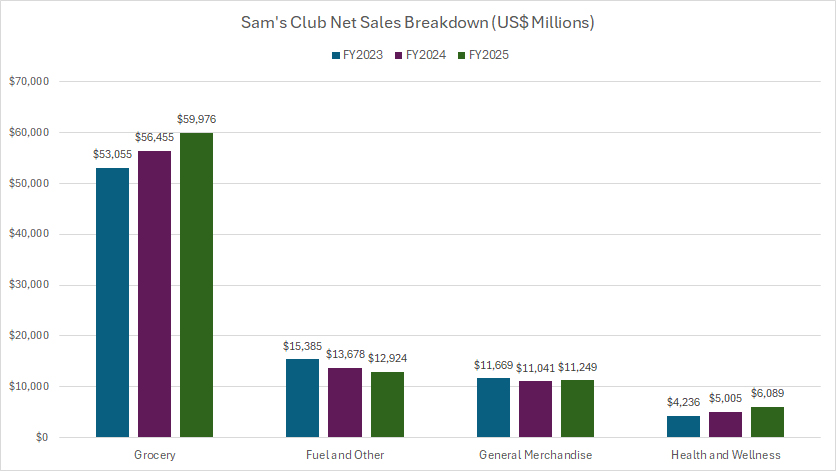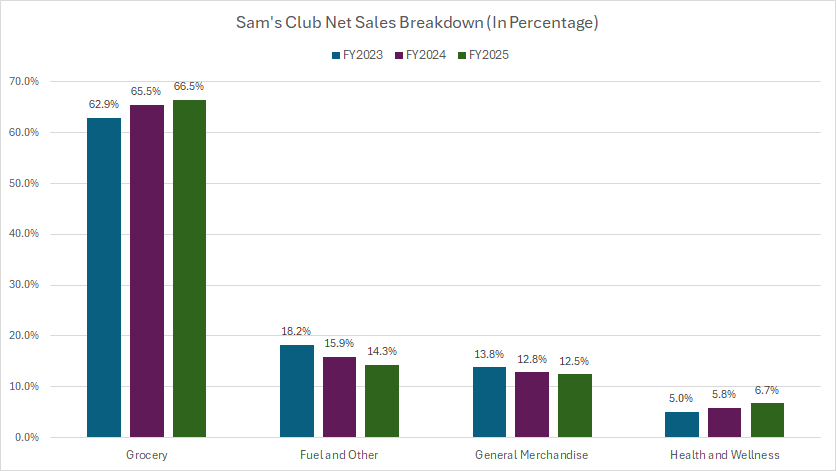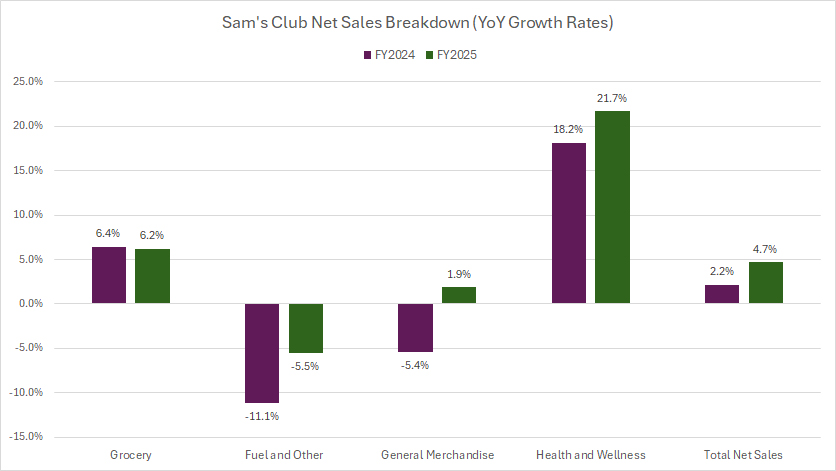
Food prices. Pexels Images.
This article provides an overview of Sam’s Club revenue, including a detailed breakdown by merchandise category.
The revenue figures are based on the segment’s net sales revenue, also referred to as merchandise sales revenue.
Sam’s Club merchandise sales are organized into four core categories: Grocery, Fuel and Other, General Merchandise, and Health & Wellness.
Do note that the merchandise sales revenue does not include membership fee revenue. Also, sales revenue from Walmart U.S. segment are not included in this discussion.
Let’s look at the results!
For other key statistics of Walmart, you may find more resources on these pages:
Sales
Revenue
- Revenue by region: U.S. and International,
- Revenue type: net sales and membership & other income,
- Revenue segments: U.S., International, and Sam’s Club,
Other Revenue Streams
- eCommerce revenue by segment: U.S., International, and Sam’s Club,
- Fuel sales revenue and profit margin,
- Membership fee revenue,
Profit Margin
- Profit margin by segment: U.S., International, and Sam’s Club,
- Walmart vs Costco: profit margin comparison,
Other Statistics
- Capital expenditures breakdown,
- Comparable sales by calendar period,
- Worldwide store count and locations breakdown by region,
- revenue per store,
Please use the table of contents to navigate this page.
Table Of Contents
Definitions And Overview
- Merchandise Sales
- Sam’s Club U.S.
- Grocery
- Fuel Sales
- General Merchandise
- Health and Wellness
- Omni-Channel
Consolidated Net Sales
A1. Sam’s Club Total Net Sales
Net Sales By Merchandise Category
B1. Net Sales from Grocery, Fuel, General Merchandise, and Health & Wellness
B2. Percentage of Net Sales from Grocery, Fuel, General Merchandise, and Health & Wellness
Net Sales By Merchandise Category (Legacy)
C1. Net Sales from Grocery, Fuel, Home & Apparel, Health & Wellness, and Technology & Office
Net Sales Growth
D1. YoY Growth Rates of Net Sales from Grocery, Fuel, General Merchandise, and Health & Wellness
Summary And Reference
S1. Insight
S2. References and Credits
S3. Disclosure
Definitions
To help readers understand the content better, the following terms and glossaries have been provided.
Merchandise Sales: Sam’s Club merchandise sales refers to the revenue generated from selling goods across its various product categories.
This includes four primary segments: Grocery, Fuel, General Merchandise, and Health & Wellness.
Merchandise sales represent the company’s net sales revenue, which excludes membership fees or other non-merchandise income streams.
Sam’s Club U.S.: Sam’s Club is a membership-only warehouse club owned by Walmart. It was founded in 1983 and named after Walmart’s founder, Sam Walton.
The club operates on a bulk-buying model, offering discounted prices on a wide range of products, including groceries, electronics, and household goods.
Sam’s Club competes with other warehouse retailers like Costco and BJ’s Wholesale Club, providing exclusive member benefits such as cash rewards, fuel discounts, and free shipping for higher-tier members.
As of fiscal year 2025, Sam’s Club has over 600 locations across the United States, along with additional stores in Mexico and China.
Grocery: Walmart’s Grocery segment is a core part of its retail operations, encompassing food and beverage products, household essentials, and consumables.
This segment includes fresh produce, dairy, meat, bakery items, frozen foods, and packaged goods. It also covers beverages, snacks, and pantry staples.
Grocery sales contribute significantly to Walmart’s overall revenue, making it a dominant player in the supermarket industry.
The company leverages competitive pricing, private-label brands, and bulk purchasing strategies to maintain affordability and attract a broad customer base.
Fuel Sales: Sam’s Club fuel sales refer to the revenue generated from selling gasoline at Sam’s Club fuel centers, which are exclusively operated under Walmart’s membership-based warehouse segment.
Unlike standalone Walmart-branded fuel stations, all of Walmart’s fuel revenue comes from Sam’s Club locations.
General Merchandise: Walmart’s General Merchandise segment encompasses a wide range of non-grocery products, including apparel, electronics, home goods, toys, sporting equipment, and seasonal items.
This segment plays a crucial role in Walmart’s overall revenue, contributing significantly to its retail dominance.
Unlike the Grocery segment, General Merchandise relies more on discretionary spending, meaning sales can fluctuate based on consumer trends and economic conditions.
Walmart leverages competitive pricing, private-label brands, and bulk purchasing to maintain affordability and attract customers.
Health & Wellness: Walmart’s Health & Wellness segment includes a range of products and services focused on personal care, pharmaceuticals, and medical essentials.
This category covers over-the-counter medications, prescription drugs, vitamins, supplements, and personal health products. Walmart also integrates healthcare services, such as in-store pharmacies and vision centers, to enhance accessibility for customers.
This segment plays a crucial role in Walmart’s retail strategy, catering to consumer demand for affordable healthcare solutions. The company leverages competitive pricing and private-label brands to maintain its market position.
Omni-Channel: Omni-channel refers to a strategy in commerce and customer engagement that provides a seamless and integrated experience across all channels, whether they are online, offline, or hybrid. It’s about making every interaction — from browsing products online to visiting a physical store—feel connected and consistent.
For example:
-
In retail, omni-channel could mean a customer can browse products online, reserve an item on a mobile app, and pick it up in-store, all while receiving consistent information and support.
-
In customer service, omni-channel ensures that whether a customer contacts a company via email, chat, phone, or social media, their inquiries and interactions are unified across these platforms.
The key idea is to break down silos between channels and prioritize the customer’s convenience. Businesses that adopt omni-channel approaches often see improved customer satisfaction and loyalty.
Sam’s Club Total Net Sales
sams-club-total-net-sales
(click image to expand)
Sam’s Club derives its net sales revenue primarily from merchandise sales. You may find more information about Sam’s Club merchandise sales here: merchandise sales
For the definition of Sam’s Club segment, you may refer to this section: Sam’s Cliub U.S.
Sam’s Club total net sales have significantly increased over the past three years spanning 2023 to 2025. Here is the result of Sam’s Club sales revenue:
Net Sales in FY2025:
| Category | Sales |
|---|---|
| (US$ Billions) | |
| Consolidated | $90.2 |
2-Year Net Sales Trend from FY2023 to FY2025:
| Category | Sales | % Changes |
|---|---|---|
| (US$ Billions) | ||
| Consolidated | $84.3 to $90.2 | +7.0% |
Net Sales from Grocery, Fuel, General Merchandise, and Health & Wellness
sams-club-net-sales-breakdown
(click image to expand)
Sam’s Club derives its net sales revenue primarily from merchandise sales. You may find more information about Sam’s Club merchandise sales here: merchandise sales
For the definition of Sam’s Club segment, you may refer to this section: Sam’s Cliub U.S.
Sam’s Club derives the majority of its revenue from sales of grocery, while fuel and other sales make up a significant portion of its revenue. Here is the breakdown:
Net Sales in FY2025:
| Category | Sales |
|---|---|
| (US$ Billions) | |
| Grocery | $60.0 |
| Fuel and Other | $12.9 |
| General Merchandise | $11.2 |
| Health & Wellness | $6.1 |
2-Year Net Sales Trend from FY2023 to FY2025:
| Category | Sales | % Changes |
|---|---|---|
| (US$ Billions) | ||
| Grocery | $53.1 to $60.0 | +13.0% |
| Fuel and Other | $15.4 to $12.9 | -16.0% |
| General Merchandise | $11.7 to $11.2 | -3.6% |
| Health & Wellness | $4.2 to $6.1 | +43.7% |
Percentage of Net Sales from Grocery, Fuel, General Merchandise, and Health & Wellness
sams-club-net-sales-breakdown-in-percentage
(click image to expand)
Sam’s Club derives its net sales revenue primarily from merchandise sales. You may find more information about Sam’s Club merchandise sales here: merchandise sales
For the definition of Sam’s Club segment, you may refer to this section: Sam’s Cliub U.S.
Ther majority of Sam’s Club revenue is from sales of grocery. Fuel and other products constitute the second-largest revenue portion, while general merchandise contributes the third-largest portion.
Health and wellness products make up less than 10% of Sam’s Club total net sales. Here is a more detailed result:
Revenue Share in FY2025:
| Category | Revenue Share (%) |
|---|---|
| Grocery | 66.5% |
| Fuel and Other | 14.3% |
| General Merchandise | 12.5% |
| Health & Wellness | 6.7% |
3-Year Trend from FY2023 to FY2025:
| Category | Revenue Share (%) | % Point Changes |
|---|---|---|
| Grocery | 62.9% to 66.5% | +3.6% |
| Fuel and Other | 18.2% to 14.3% | -3.9% |
| General Merchandise | 13.8% to 12.5% | -1.4% |
| Health & Wellness | 5.0% to 6.7% | +1.7% |
Net Sales from Grocery, Fuel, Home & Apparel, Health & Wellness, and Technology & Office
sams-club-net-sales-breakdown-legacy
(click image to expand)
This section presents the legacy revenue category, which Walmart reorganized into new categories starting in fiscal year 2025.
Grocery and consumables category accounts for the largest portion of Sam’s Club revenue, as shown in the chart above. Here is a more detailed breakdown:
Net Sales in FY2024:
| Category | Sales |
|---|---|
| (US$ Billions) | |
| Grocery and consumables | $56.4 |
| Fuel, tobacco, and other | $12.9 |
| Home and Apparel | $9.3 |
| Health & Wellness | $5.0 |
| Technology, Office, & Entertainment | $2.6 |
3-Year Trend from FY2021 to FY2024:
| Category | Sales | % Changes |
|---|---|---|
| (US$ Billions) | ||
| Grocery and consumables | $42.1 to $56.4 | +33.9% |
| Fuel, tobacco, and other | $7.6 to $12.9 | +69.4% |
| Home and Apparel | $7.3 to $9.3 | +26.2% |
| Health & Wellness | $3.8 to $5.0 | +32.0% |
| Technology, Office, & Entertainment | $3.0 to $2.6 | -14.2% |
YoY Growth Rates of Net Sales from Grocery, Fuel, General Merchandise, and Health & Wellness
sams-club-net-sales-breakdown-yoy-growth-rates
(click image to expand)
Sam’s Club derives its net sales revenue primarily from merchandise sales. You may find more information about Sam’s Club merchandise sales here: merchandise sales
For the definition of Sam’s Club segment, you may refer to this section: Sam’s Cliub U.S.
Revenue Growth in FY2025
| Category | Growth Rates |
|---|---|
| Grocery | +6.2% |
| Fuel and Other | -5.5% |
| General Merchandise | +1.9% |
| Health & Wellness | +21.7% |
| Consolidated | +4.7% |
2-Year Average Revenue Growth from FY2024 to FY2025:
| Category | Growth Rates |
|---|---|
| Grocery | +6.3% |
| Fuel and Other | -8.3% |
| General Merchandise | -1.7% |
| Health & Wellness | +19.9% |
| Consolidated | +3.4% |
Insight
Essentially, Sam’s Club’s grocery segment remains the dominant revenue contributor, accounting for 66.5% of total net sales in FY2025.
On the other hand, Fuel & Other revenue declined significantly, falling from $15.4 billion to $12.9 billion — a 16.0% drop. This decline suggests potential challenges related to fluctuating fuel prices, changes in consumer purchasing behavior, or broader economic factors affecting fuel demand.
General Merchandise sales have slightly decreased from $11.7 billion to $11.2 billion, reflecting a 3.6% decline. This segment includes discretionary spending items such as apparel, electronics, and household goods, which are more sensitive to economic conditions. A softer demand for non-essential products could explain the gradual dip in revenue, though the category still holds a substantial 12.5% share of total net sales.
Health & Wellness has emerged as a key growth driver, experiencing a remarkable surge from $4.2 billion to $6.1 billion — a 43.7% increase. The expansion of in-store pharmacies and wellness-related offerings has likely contributed to this strong performance.
From a strategic perspective, Sam’s Club appears to be reinforcing its grocery sales while fuel revenues face headwinds. The increasing significance of Health & Wellness suggests a broader shift in consumer priorities, with the potential for continued expansion in this segment.
References and Credits
1. All financial figures presented were obtained and referenced from Walmart’s annual reports published on the company’s investor relations page: Walmart Investor Relations.
2. Pexels Images.
Disclosure
We may use artificial intelligence (AI) tools to assist us in writing some of the text in this article. However, the data is directly obtained from original sources and meticulously cross-checked by our editors multiple times to ensure its accuracy and reliability.
If you find the information in this article helpful, please consider sharing it on social media. Additionally, providing a link back to this article from any website can help us create more content like this in the future.
Thank you for your support and engagement! Your involvement helps us continue to provide high-quality, reliable content.





